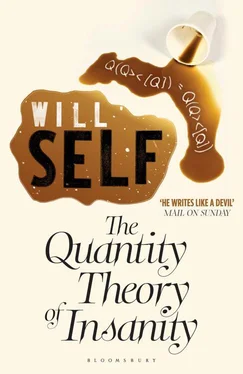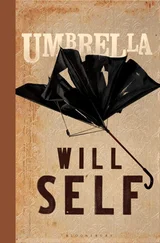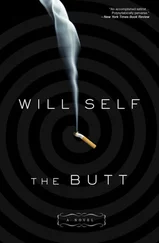The idiot’s hair had been chopped into a ragged tonsure. He wore a blue hooded anorak and bell-bottomed corduroy trousers, and rocked as he sang. As I passed by I looked into his face; it was a face like the bench he sat on, a sad, forlorn piece of municipal furniture — although the morning sun shone bright, this face was steadily being drizzled on.
This particular idiot lay outside my jurisdiction. He was, as it were, un-gazetted. I knew that by ignoring the opportunity to indulge in the sickly bellyburn of self-piteous caring, I was facing up to an occupational challenge. If I was to have any success in my new job I would need to keep myself emotionally inviolate, walled off. For, this morning, I was to begin an indefinite appointment as art therapist, attached to Ward 9. My destination was the squat fifteen-storey building that rose up ahead of me, out of the tangled confluence of Camden Town.
I bounced down the hill, the decrease in altitude matched pace for pace by the mounting density of the air. The freshness of the atmosphere on Parliament Hill gave way to the contaminated cotton wool of ground-floor, summer London. Already, at 8.45 a.m., the roads around Gospel Oak were solidly coagulated with metal while shirtsleeved drivers sat and blatted out fumes.
As I picked my way through the streets the hospital appeared and then disappeared. Its very vastness made its sight seem problematic. In one street the horizon would flukily exclude it in such a convincing way that it might never have existed, but when I rounded the corner there was its flank rearing up — the grey-blue haunch of some massive whale — turning away from me, sending up a terrace of concrete flats with a lazy flip of its giant tail.
I walked and walked and the hospital never seemed to get any closer. Its sloping sides were banded with mighty balconies, jutting concrete shelves the size of aircraft carrier flight decks. The front of the building was hidden behind a series of zigzagging walkways and ramps that rose in crisscross patterns from the lower ground to the third floor. At the hospital’s feet and cuddled in the crook of its great wings-for-arms, were tumbles of auxiliary buildings: nurses’ flatlets; parking fortlets; generator units two storeys high, housed in giant, venetian-blind-slatted boxes; and ghostly incinerators, their concrete walls and chimneys blackened with some awful stain.
I rounded the end of the street and found myself, quite suddenly, at the bottom of a ramp that led straight up to the main entrance. The two previous times I had been to the hospital it was a working wasps’ nest in full diurnal swing. But now, their photoelectric cells disconnected, the main doors to the hospital were wedged open with orange milk crates. I picked my way through the long, low foyer, past the shop, at this hour still clad in its roll-over steel door, and in between miscellaneous islands of freestanding chairs, bolted together in multiples of two, seemingly at random. They were thinly upholstered in the same blue fabric as the floor covering. The room was lit by flickering strips of overhead neon, so that the whole effect was ghostly; the overwhelming impression was that this was a place of transit, an air terminal for the dying. It was impossible to differentiate the ill from the dossers who had leaked in from the streets and piled their old-clothes forms into the plastic chairs. All were reduced and diminished by the hospital’s sterile bulk into untidy parasites. The occasional nurse, doctor or auxiliary walked by briskly. They were uniformed and correct, clearly members of some other, genetically distinct, grouping.
In the glassed-in corridor that led to the lifts there was an exhibition of paintings — not by the patients, but by some pale disciple of a forgotten landscape school. The etiolated blues and greens chosen to take the place of hills and plains were flattened to sheens behind glass, which reflected the dead architectural centre of the hospital: an atrium where a scree of cobblestones supported uncomfortable concrete tubs, which in turn sprouted spindly, spastic trees.
I shared the lift to the ninth floor with a silent young man in green, laced at hip and throat. His sandy, indented temples with their gently pulsing veins aroused in me an attack of itchy squeamishness — I had to touch what repelled me. I scratched the palms of my hands and longed to take off my shoes and scratch the soles of my feet. The itch spread over my body like a hive and still I couldn’t take my eyes off that pulsing tube of blood, so close to both surface and bone.
At the ninth floor the sandy man straightened up, sighed, and disappeared off down a corridor with an entirely human shrug.
I’d been on to the ward before, albeit briefly, when Dr Busner had shown me round after the interview. What had struck me then and what struck me again now was the difference in smell between Ward 9 and the rest of the hospital. Elsewhere the air was a flat filtered brew; superficially odourless and machined, but latent with a remembered compound of dynasties of tea bags — squeezed between thumb and plastic spoon — merging into extended families of bleaching, disinfecting froths and great vanished tribes of plastic bags. But in Ward 9 the air had a real quality, it clamped itself over your face like a pad of cotton wool, soaked through with the sweet chloroform of utter sadness.
A short corridor led from the mouth of the lift to the central association area of the ward. This was a roughly oblong space with the glassed-off cabinet of the nurses’ station on the short lift side; a dining area to the right looking out through a long strip of windows over the city; to the left were the doors to various offices and one-to-one treatment rooms; and straight ahead another short corridor led to the two dormitories.
Every attempt had been made to present Ward 9 as an ordinary sort of place where people were treated for mental illnesses. There were bulletin boards positioned around the association area festooned with notices, small ads, flyers for theatrical performances by groups of hospital staff, clippings from newspapers, drawings and cartoons by the patients. Over in the dining area a few of the tables had rough clay sculptures blobbed on them, left there like psychotic turds. I assumed that they were the products of my predecessor’s last art therapy session. Around the open part of the area there were scattered chairs, the short-legged, upholstered kind you only find in institutions. And everywhere the eye alighted — the dining area, the nurses’ station, dotted in the open area — were ashtrays. Ashtrays on stands, cut-glass ashtrays, lopsided spiral clay ashtrays, ashtrays bearing the names of famous beers; all of them overflowing with butts.
There are two kinds of institution that stand alone on the issue of smoking. Whereas everywhere else you go you encounter barrages of signs enjoining you to desist, slashing your cigarette through with imperious red lines, in psychiatric wards and police stations the whole atmosphere positively cries out to you, ‘Smoke! Smoke! We don’t mind, we understand, we like smoking!’ Ward 9 was no exception to this rule. Empty at this hour (the patients had no reason to get up, they didn’t roll over in their beds at 8.00 sharp and think to themselves, ‘Ooh! I must get up quickly and have my shot of thorazine …’), the whole ward still whirled and eddied with last night’s acrid work.
I walked down the short corridor to the nurses’ station. A young man sat behind the desk completely absorbed in a dogeared paperback. He wore a black sweat shirt and black Levis; his sneakered feet, propped on the cluttered shelf of clipboards and Biros, pushed the rest of him back and up on two wheels of his swivel chair. As I stood and observed him, he rocked gently from side to side, his body unconsciously mirroring the short, tight arcs that his eyes made across the page.
Читать дальше












